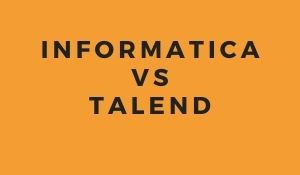
What is Informatica PowerCenter?
Informatica PowerCenter is ETL i.e. extraction, transformation, loading device useful in structuring enterprise warehouses. Because of its incredible obtainability in addition to being completely mountable and high-performing, it provides the basis for all major projects of data integration and creativity all over the enterprise. Some of the areas are data governance, warehousing, and migration, replication, synchronization, B2B exchange. It can provide reliable explanations to the IT organization, global IT squads, developers and business analysts as it brings not only statistics that are reliable and assured to provide logical and operative requirements of the corporate, but additionally suggests support to numerous data integration plans and teamwork between the occupational and IT from corner to corner of the globe.
Informatica PowerCenter permits access to almost any data foundation from one stand. PowerCenter is capable of delivering data on request, with real-time, group/batch, or CDC i.e. change data capture. Informatica PowerCenter is used to accomplish the management of the widest range of data incorporation creativities as a solitary stand. This ETL implementation makes it promising to shorten the expansion of data warehouses as well as data marts.
Informatica with PowerCenter Options encounters organization potentialities and requirements for security and scalability with collaboration with abilities like dynamic partitioning, seamless recovery, Metadata management, Data masking, Grid computing support, etc. PowerCenter proposals are a significant variety of elements meant for global IT groups and manufacture administrators, as well as for separate developers and specialists. E.g. to combine metadata into an integrated unified catalog, the metadata manager is there. Development skills are taken care of through team-based administration. Collaboration between manifold professionals is taken care of by visual tools set alongside with other productivity tools.

Strengths:
- A highly efficient and reliable tool
- Easily expandable and Stable
- Supports most of the industry-standard data types
- Efficient to deal with complicated lookup transformations
- Supports multi-user client-server development interface
Weaknesses:
- Does not have the feature of Data Quality, it needs to be treated programmatically.
- Does not have any web integration feature.
- PowerCenter does not generate code, all the mappings developed are in the form of GUI Interface
What is Talend?
Today’s world is focused on Big data, cloud, etc. For big corporations, it is very significant to remain linked with company information. Talend helps in changing the data into business visions.
It is an open-source platform for data integration. It offers various software as well as services to integrate data, manage it, and maintain quality along with organization application integration. Other services provided are cloud storage with Big Data. It first originated into the market in 2005 as the first profitable open-source software seller of data combination software.
Talend is recognized to be the following group frontrunner in the cloud plus Big Data incorporation software. It offers assistance to organizations in making real-time preferences and becoming data-driven. It makes data more accessible through enhancing its best and it can be relocated swiftly to the destination systems.
Strengths:
- Cost-effective
- Easy to customize
- Lots of built-in adapters easily available
- Ease of deployment
- Provides data quality elements and permits us to write customized queries
Weaknesses:
- The scheduling function is not available with open source edition
- Backup and recovery feature is no longer available

Comparison Table between Talend Vs Informatica PowerCenter
| Parameters | Talend | Informatica |
|---|---|---|
| Commercial or Open source | Talend offers multiple solutions for data integration, both open source, and commercial editions | Informatica provides only commercial data integration |
| Pricing |
Open source edition is available free of cost |
Charges applicable for single/ multiuser license |
| Popularity |
Most popular open-source ETL tool |
Most mature ETL product in the market |
| Platform |
Talend generates native Java code which allows you to run it on any platform which supports Java |
Informatica generates metadata that is stored in RDBMS repository; it does not generate any code |
| Custom codes |
Custom code can be written efficiently |
Integrating custom code using Java transformation is not so efficient |
|
Learning |
Requires Java knowledge |
Easy to learn and use the tool with limited knowledge. Even business users can understand the mapping and logic applied |
|
Deployment |
Ease of deployment |
Deployment automation needs to be improved |
|
Re-usability |
Reusable components can be generated |
Transformations are reusable |
|
Scheduling |
Open source edition does not support job scheduling, but commercial does with Talend Administration Console |
It is possible to schedule jobs using server manager |
|
Parallelism |
Talend supports parallelism with commercial edition, but not with open source |
Supports parallelism, multiple mapping sessions can be executed on the same server |
|
Backup & Recovery |
No such feature in open source |
Backup and recovery can be done with a repository manager. |
Conclusion
Taking into account all the aspects of Talend and Informatica PowerCenter we can say that each tool enables the identical task of transformation and data integration. However, Informatica is relatively specialized in ETL and Data integration. It’s the market leader in the ETL domain. But, if you prefer to go for open source and you are familiar with Java then go for Talend. It is more affordable than Informatica in terms of cost, training, and resource allocation. Also, it is up to date on Big Data Technologies like Spark, Hive, AWS, etc.










